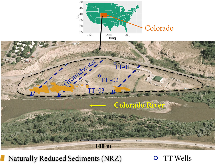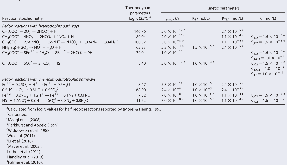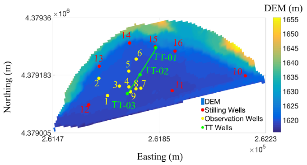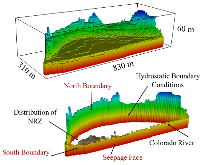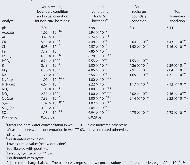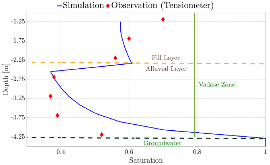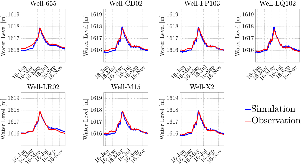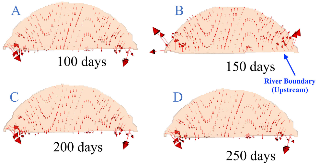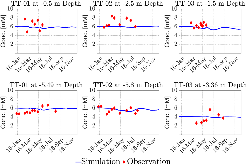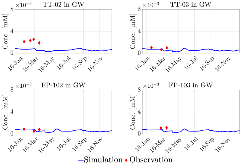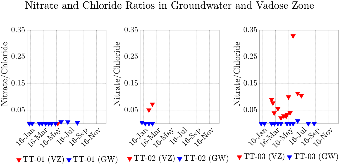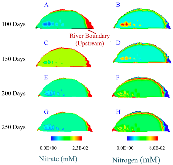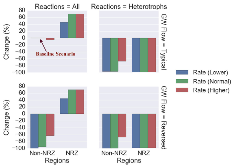|
Multicomponent reactive transport modeling of uranium bioremediation field experiments
|
journal
|
October 2009 |
|
Stimulating the In Situ Activity of Geobacter Species To Remove Uranium from the Groundwater of a Uranium-Contaminated Aquifer
|
journal
|
October 2003 |
|
Seasonal biogeochemical hotspots in the streambed around restoration structures
|
journal
|
August 2008 |
|
Effects of physical and geochemical heterogeneities on mineral transformation and biomass accumulation during biostimulation experiments at Rifle, Colorado
|
journal
|
March 2010 |
|
Landscape controls on nitrate removal in stream riparian zones: LANDSCAPE CONTROLS ON NITRATE REMOVAL
|
journal
|
March 2004 |
|
A numerical transport model for oxygen- and nitrate-based respiration linked to substrate and nutrient availability in porous media
|
journal
|
September 1988 |
|
Evaluating the performance of parallel subsurface simulators: An illustrative example with PFLOTRAN: Evaluating the Parallel Performance of Pflotran
|
journal
|
January 2014 |
|
Physico-Chemical Heterogeneity of Organic-Rich Sediments in the Rifle Aquifer, CO: Impact on Uranium Biogeochemistry
|
journal
|
December 2015 |
|
Microbiological regulation of the biogeochemical nitrogen cycle
|
journal
|
February 1982 |
|
Metatranscriptomic evidence of pervasive and diverse chemolithoautotrophy relevant to C, S, N and Fe cycling in a shallow alluvial aquifer
|
journal
|
March 2016 |
|
Rate-limited U(VI) desorption during a small-scale tracer test in a heterogeneous uranium-contaminated aquifer: RATE-LIMITED U(VI) DESORPTION IN A U-CONTAMINATED AQUIFER
|
journal
|
May 2012 |
|
Oxidative Uranium Release from Anoxic Sediments under Diffusion-Limited Conditions
|
journal
|
September 2017 |
|
Residence time control on hot moments of net nitrate production and uptake in the hyporheic zone: RESIDENCE TIME CONTROL ON TEMPORAL HYPORHEIC NITRATE CYCLING
|
journal
|
June 2013 |
|
Multicomponent reactive transport modeling in variably saturated porous media using a generalized formulation for kinetically controlled reactions: REACTIVE TRANSPORT MODELING IN VARIABLY SATURATED MEDIA
|
journal
|
September 2002 |
|
Control Points in Ecosystems: Moving Beyond the Hot Spot Hot Moment Concept
|
journal
|
January 2017 |
|
Geochemical, mineralogical and microbiological characteristics of sediment from a naturally reduced zone in a uranium-contaminated aquifer
|
journal
|
August 2012 |
|
Uranium Bioreduction Rates across Scales: Biogeochemical Hot Moments and Hot Spots during a Biostimulation Experiment at Rifle, Colorado
|
journal
|
August 2014 |
|
Riparian biogeochemical hot moments induced by stream fluctuations: HYDROLOGICALLY DRIVEN RIPARIAN BUFFERING EFFECTS
|
journal
|
September 2012 |
|
Association of Novel and Highly Diverse Acid-Tolerant Denitrifiers with N2O Fluxes of an Acidic Fen
|
journal
|
December 2009 |
|
Mineral Transformation and Biomass Accumulation Associated With Uranium Bioremediation at Rifle, Colorado
|
journal
|
July 2009 |
|
Identification and mitigation of nitrate leaching hot spots using NLEAP-GIS technology
|
journal
|
December 1995 |
|
Deep Vadose Zone Respiration Contributions to Carbon Dioxide Fluxes from a Semiarid Floodplain
|
journal
|
January 2016 |
|
Water Table Dynamics and Biogeochemical Cycling in a Shallow, Variably-Saturated Floodplain
|
journal
|
March 2017 |
|
Mineral properties, microbes, transport, and plant-input profiles control vertical distribution and age of soil carbon stocks
|
journal
|
April 2017 |
|
Biogeochemical Hot Spots and Hot Moments at the Interface of Terrestrial and Aquatic Ecosystems
|
journal
|
June 2003 |
|
A mechanistic treatment of the dominant soil nitrogen cycling processes: Model development, testing, and application: NITROGEN CYCLE MODELING
|
journal
|
April 2008 |
|
Thermodynamics and Kinetics of Sulfide Oxidation by Oxygen: A Look at Inorganically Controlled Reactions and Biologically Mediated Processes in the Environment
|
journal
|
January 2011 |
|
Microbiological and Geochemical Heterogeneity in an In Situ Uranium Bioremediation Field Site
|
journal
|
October 2005 |
|
Acetate Availability and its Influence on Sustainable Bioremediation of Uranium-Contaminated Groundwater
|
journal
|
June 2011 |
|
A multiple-continuum model for simulating single-phase and multiphase flow in naturally fractured vuggy reservoirs
|
journal
|
July 2011 |
|
Field evidence of selenium bioreduction in a uranium-contaminated aquifer: Field evidence of selenium bioreduction
|
journal
|
February 2013 |
|
Uranium in Framboidal Pyrite from a Naturally Bioreduced Alluvial Sediment
|
journal
|
November 2009 |
|
Identifying geochemical hot moments and their controls on a contaminated river floodplain system using wavelet and entropy approaches
|
journal
|
November 2016 |
|
Influence of hydrological, biogeochemical and temperature transients on subsurface carbon fluxes in a flood plain environment
|
journal
|
February 2016 |
|
Denitrification in the Mississippi River network controlled by flow through river bedforms
|
journal
|
October 2015 |
|
Hot spots and hot moments of carbon and nitrogen dynamics in a semiarid riparian zone: RIPARIAN HOT SPOTS AND HOT MOMENTS
|
journal
|
March 2008 |
|
Modern marine sediments as a natural analog to the chemically stressed environment of a landfill
|
journal
|
October 1979 |
|
No Measurable Changes in 238 U/ 235 U due to Desorption–Adsorption of U(VI) from Groundwater at the Rifle, Colorado, Integrated Field Research Challenge Site
|
journal
|
February 2013 |
|
Biostimulation induces syntrophic interactions that impact C, S and N cycling in a sediment microbial community
|
journal
|
November 2012 |
|
Kinetic modeling of microbially-driven redox chemistry of subsurface environments: coupling transport, microbial metabolism and geochemistry
|
journal
|
August 1998 |
|
Hierarchical Bayesian method for mapping biogeochemical hot spots using induced polarization imaging
|
journal
|
January 2016 |
|
Thousands of microbial genomes shed light on interconnected biogeochemical processes in an aquifer system
|
journal
|
October 2016 |
|
Upscaling Nitrogen Removal Capacity from Local Hotspots to Low Stream Orders’ Drainage Basins
|
journal
|
May 2015 |
|
Direct and Indirect Hydrological Controls on Concentration and Loading in Midwestern Streams
|
journal
|
January 2008 |
|
Variably saturated flow and multicomponent biogeochemical reactive transport modeling of a uranium bioremediation field experiment
|
journal
|
November 2011 |
|
Timing the Onset of Sulfate Reduction over Multiple Subsurface Acetate Amendments by Measurement and Modeling of Sulfur Isotope Fractionation
|
journal
|
August 2012 |
|
Surface micro-topography causes hot spots of biogeochemical activity in wetland systems: A virtual modeling experiment: MICRO-TOPOGRAPHY AND HOT SPOT FORMATION
|
journal
|
October 2012 |
|
Challenges to incorporating spatially and temporally explicit phenomena (hotspots and hot moments) in denitrification models
|
journal
|
January 2009 |
|
Geochemical and mineralogical investigation of uranium in multi-element contaminated, organic-rich subsurface sediment
|
journal
|
March 2014 |
|
Hot Spots and Persistence of Nitrate in Aquifers Across Scales
|
journal
|
January 2016 |
|
Prenatal Nitrate Intake from Drinking Water and Selected Birth Defects in Offspring of Participants in the National Birth Defects Prevention Study
|
journal
|
September 2013 |
